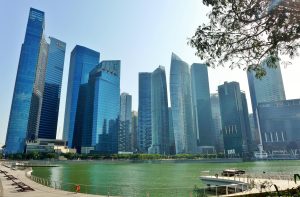DBS Research Singapore outlook 2020 said trough in the growth cycle is in the making, with outlook expected to improve gradually. GDP growth is expected to register 1.4% in 2020 while inflation should remain manageable at 1.1% next year.
The Singapore outlook 2020 report said that the economy struggled in 2019 amid the trade war and a down-cycle in electronics. The bank’s researchers said economy would have dipped into a technical recession in 2Q/3Q if not for the marginal lift from the services sector, and some respite in the manufacturing contraction.
“Advance GDP estimates for 3Q19 reported a weak growth of 0.1% YoY but the silver lining is that the economy registered a benign expansion of 0.6% QoQ saar, thereby narrowly averting a technical recession. We expect such improvement to persist in the next quarter. GDP growth in 4Q19 is likely to recover to slightly above 1.0%. With that,full year GDP growth for 2019 is expected to register 0.6%.
A trough in the growth cycle is in the making, with emerging signs of bottoming in the external environment.Barring any unforeseen external shocks, growth momentum is expected to pick up gradually in the coming quarters.”

Singapore outlook 2020 predicted that there’s bottoming out in manufacturing
Table of Contents
“On the surface, the manufacturing sector appears to remain in the doldrums. But there are signs of bottoming out in the manufacturing sector. At a growth pace of 0.4% QoQ saar, this is a marked improvement from -4.2% previously. This also corroborates with the trend seen in non-oil domestic exports (NODX). While NODX growth remains in the red, the decline has moderated from about 16% YoY in May to 9.8% on average between Aug-Oct19. Though base effect is at work, other high frequency data is also reflecting similar trend.
Electronics indicators such as the growth in semiconductor equipment billings is improving, while semiconductor shipments are rising steadily, from about USD 32bn per month in April, to USD 34bn in August. These suggest a turnaround in this key industry and reaffirm our view of a bottoming out in the overall manufacturing sector.
In short,the manufacturing sector could be turning around, but the outlook will remain challenging in the coming months, pending a more pronounced improvement in global economic conditions.”
Singapore outlook 2020, an effort by DBS’s economists and strategists, Irvin Seah, Philip Wee, Eugene Leow, and Joanne Goh, said services will remain resilient next year.
“The services sector has managed to pick up the slack despite the declines in the other key sectors in 3Q19. In fact, the services sector is the main reason for the economy averting the fate of a technical recession. This sector accounts for about two-thirds of the economy and a turnaround in this cluster is instrumental in lifting the overall economic performance.
High frequency data is showing similar signs of bottoming out in the services sector. Re-exports growth has turned positive after three consecutive months of decline, pointing to a turnaround in global trade flows and potentially better prospects for trade related services. Container throughput growth is also improving, suggesting the improved trade activity. Loan growth apparently has also bottomed, and now creeping higher on the back of stronger business loan growth.”
The report pointed to global events like the trade war between USA and China, weaknesses in the Eurozone and the slowing Chinese economy to suggest that the outlook ahead will be tepid.
“It could be a slow grind ahead.Though signs of bottoming out are emerging, the recovery could be weak. While small and agile economies such as Singapore could bounce back faster, its openness and trade dependent nature also imply vulnerability to any unexpected negative shock. Beyond the uncertainties around the trade talk, geopolitical risks in various parts of the world could test the resilience of the global economy just when growth momentum in the three major economic blocs, US, Eurozone and China, are slowing down.
Indeed, such a scenario would call for added policy support (see later section). Though the economy has averted the fate of a technical recession, a robust policy response would still be required to lift the boat amid the choppy outlook. Considering the above,GDP growth in 2020 is expected to register 1.4%, which is below Singapore’s potential growth rate, but up from a projected 0.6% this year.”
Singapore outlook 2020 said that the local labour market will remain soft, and as employment prospects have been mixed.
“Latest advance manpower report for 3Q19 saw employment growth likely registered 22,400, higher than the job growth 6,200 in the previous quarter. Yet, this is overshadowed by a marginal pick up in retrenchment to 2,900, up from 2,320 previously. Unemployment rate for residents also rose to 3.2%, up 0.1%-pt from the previous quarter.
Employment prospects would remain challenging. Apart from the weak recovery ahead, the labour market cycle typically lags the growth cycle. Moreover, some sectors within the economy will likely continue to struggle with industry specific down-cycles (e.g., retail and offshore marine). Besides cyclical factors, structural transitions within the economy (e.g., automation in manufacturing) also imply that some jobs could become irrelevant, resulting in permanent job losses.Continued emphasis on re-training and upskilling will be crucial to ensure the employability of workers.”
The bank predicted that despite major headwinds this year, earnings growth for the Singapore market remains resilient at around 5%. This, when compared to other cyclical markets such as Taiwan, Korea, Malaysia and Thailand which all recorded negative earnings growth this year, is relatively strong and the index traded in a tight range this year as a result.
“We expect earnings growth of around 5% for the next two years, to be delivered by steady stream of income from the REITS sector. Downside risks for the Banks as a result of NIM compression could be offset by cyclical earnings recovery from the Industrials sector.”






